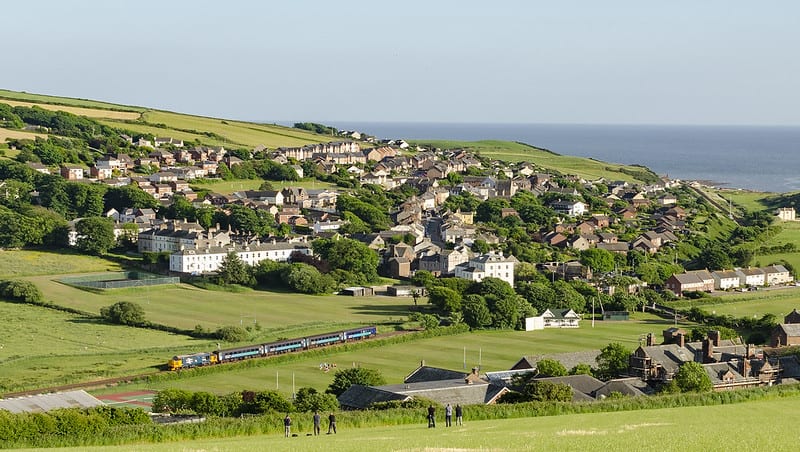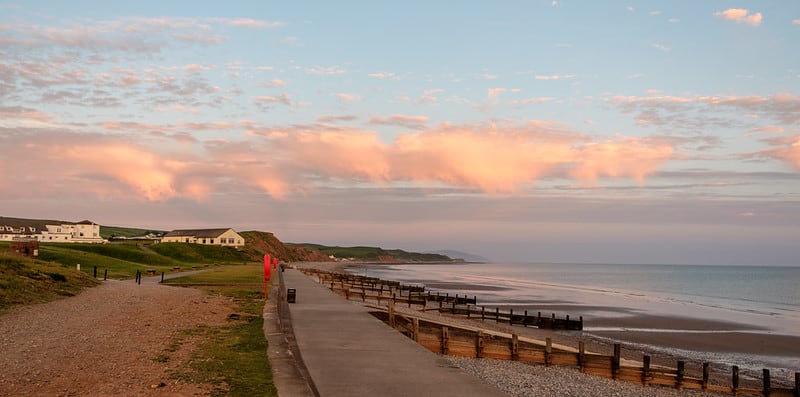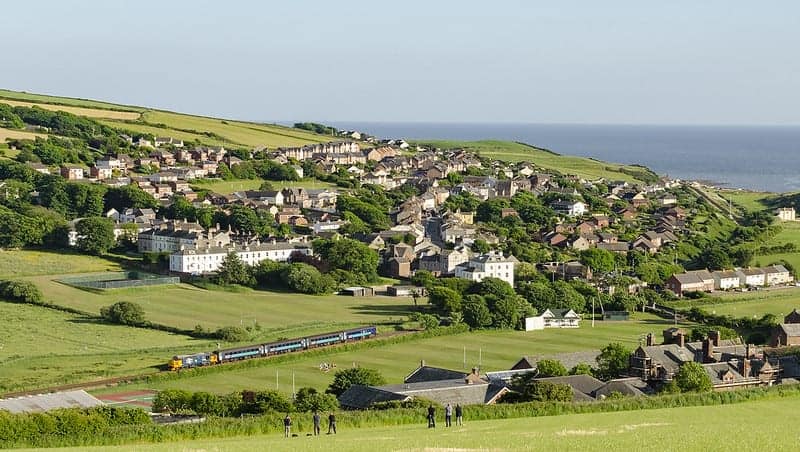St Bees is a village located in Cumbria, England. It is situated on the coast of the Irish Sea, about 3 miles (5 km) south of Whitehaven. St Bees is known for its beautiful beach and the nearby St Bees Head, a coastal nature reserve and an important site for seabirds.
St Bees is a little-known village, yet a place that made a great impact on my life. Known best by keen hikers, St Bees is the start of Wainwrights’ famous “Coast to Coast” Walk. I grew up and went to school in the village, and although I have not returned for many decades now, it is constantly in my memories. St Bees is also home to St Bees School, an international day and boarding school that was founded back in 1583 by the Archbishop of Canterbury. Famous pupils here include Rowan Atkinson, aka Mr. Bean. So, what makes St Bees such a special place?
Here are some of the major towns and cities that have direct train services to St Bees:
- Carlisle: This is the largest city in Cumbria and has a direct train service to St Bees. The journey takes around 30 minutes.
- Whitehaven: This is a coastal town located approximately 5 miles north of St Bees. There is a direct train service from Whitehaven to St Bees which takes around 10 minutes.
- Barrow-in-Furness: This is a town located in the south of Cumbria and has a direct train service to St Bees. The journey takes around 40 minutes.
- Lancaster: This is a city located in Lancashire and has a direct train service to St Bees. The journey takes around 1 hour and 30 minutes.
- Preston: This is a city located in Lancashire and has a direct train service to St Bees. The journey takes around 2 hours.
These are just some of the towns and cities that have direct train services to St Bees. There may be other towns and cities that have indirect train services to St Bees, which would require a transfer at a larger station such as Carlisle or Lancaster.
Must Do
The landscape at St Bees is simply stunning, St Bees Head comprising red sandstone cliffs that tower 80 metres above sea level. A brisk walk up to the head, starting at the main North beach in St Bees will take you to the once-inhabited lighthouse, and stunning views across West Cumbria and across to the Isle of Man (on clear days). St Bees boasts 2 beaches, as well as a caravan park for traditional seaside holidays, a spattering of local shops, and at least 4 public houses. Down at the North beach you will also find the Seacote Hotel, the perfect place to rest up before the start of the Coast to Coast trek.
St Bees is a charming coastal village located in the county of Cumbria in northwest England. With its picturesque scenery, fascinating history, and a range of attractions, it is a great destination for visitors looking to explore the beauty of this part of the country. In this article, we will be exploring the best tourist sites in St Bees Cumbria.
- St Bees Beach St Bees Beach is one of the most popular tourist attractions in the area. It is a long, sandy beach with stunning views of the sea and the cliffs. Visitors can enjoy a leisurely walk along the beach, swim in the sea, or simply relax and soak up the sun. The beach is also a popular spot for birdwatching, with a variety of seabirds nesting on the cliffs.
- St Bees Head St Bees Head is a rugged headland that offers stunning views of the coast and the Irish Sea. It is a great place for hiking and walking, with a number of trails leading to the top of the headland. From the top, visitors can enjoy panoramic views of the surrounding landscape, including the Lake District and the Isle of Man.
- St Bees Priory St Bees Priory is a historic church that dates back to the 12th century. It is one of the finest examples of Norman architecture in the country and is known for its intricate stone carvings and stained glass windows. Visitors can take a guided tour of the church and learn about its fascinating history.
- Coast to Coast Walk The Coast to Coast Walk is a famous long-distance trail that runs from St Bees to Robin Hood’s Bay on the east coast of England. The trail covers 192 miles and takes walkers through some of the most spectacular scenery in the country, including the Lake District and the North York Moors. St Bees is the starting point for the walk, and many walkers choose to spend a night in the village before setting off on their journey.
- Haig Colliery Mining Museum The Haig Colliery Mining Museum is a fascinating museum that tells the story of the coal mining industry in the area. Visitors can learn about the life and work of the miners and explore the old colliery buildings. The museum is located on the site of the former Haig Colliery, which was once one of the largest coal mines in the country.
In conclusion, St Bees Cumbria has a range of tourist sites that are well worth a visit. From its beautiful beaches and rugged headlands to its historic churches and museums, there is something for everyone in this charming village. Whether you are a history buff, a nature lover, or an outdoor enthusiast, St Bees is the perfect destination for your next holiday.
The Legend of St Bega
The village of St Bees is situated on the West Cumbrian Coast, four miles south of Whitehaven, a town that was dominated by the mining industry up until the 1980’s. The rocky promontory that is St Bees Head, it the most westerly point of Cumbria, and it was here, in the 9th Century that an Irish Nun became shipwrecked. According to the legend, Saint Bega, and other nuns that survived the shipwreck went to ask Lord Egremont for land where they could build a priory.
It was midsummer, and the Lord responded that they could have any land covered by snow the next day. Much to his surprise, the land between the sea and the castle were covered by snow the next day, and the priory that officially dates back to 1130 was built. The priory is, to this day, a focal point of St Begian life, the whole school gathering there for prayer and celebration throughout the school term. Other buildings that dominate the landscape of St Bees are the “Quadrangle”, the original building of St Bees School.

Restaurants, Bars, and Eateries
As St Bees is a village of just 1,800 inhabitants, it is understandable that there isn’t much nightlife to be found in the village. St Bees is a place people visit to get back to nature, learn about historical buildings, and of course, for hiking the Coast to Coast route.
Good pub grub and traditional food is widely available, and for a more elegant choice, Lulu’s bistro in the village is the perfect location for a romantic dinner. Run by a personal friend of mine, Lulu’s also caters for overnight guests during the summer season, her establishment being set in the very interesting old railway station buildings. St Bees is still accessible by train and is a request stop on the Carlisle to Barrow-in-Line. But don’t worry about being kept awake at night by the trains; the service runs during the day and evening only.
Here are some other places to eat in St Bees
- The Greyhound Inn is a traditional pub located in the heart of St Bees. It serves a variety of pub food, including burgers, sandwiches, and salads.
- The St Bees Kitchen is a popular café located in the center of the village. It serves a range of dishes, including sandwiches, soups, and baked goods.
- The Beachcomber Café is a seaside café located on the beach in St Bees. It serves a range of snacks and light meals, including sandwiches, cakes, and ice cream.
- The Seacote Hotel is a stylish hotel located on the coast of St Bees. It has a restaurant that serves a range of dishes, including seafood, meat, and vegetarian options.
- The Mountaineer is a popular café and takeaway located in the center of the village. It serves a range of dishes, including sandwiches, paninis, and burgers.
- The Whitehaven Golf Club is a golf club located just outside of St Bees. It has a restaurant that serves a range of dishes, including sandwiches, salads, and main courses.
- The Station Hotel is a traditional hotel located in the center of St Bees. It has a restaurant that serves a range of dishes, including pub classics and local specialties.
- The Ice Cream Parlour is a popular ice cream shop located in the center of St Bees. It serves a range of ice cream flavors and other sweet treats.
- The Ship Inn is a traditional pub located in the center of St Bees. It serves a range of pub food, including burgers, sandwiches, and main courses.
- The Italian Kitchen is an Italian restaurant located in the center of St Bees. It serves a range of dishes, including pasta, pizza, and main courses.

Best Places to Stay in St Bees
Being a small town there are limited options for accommodation. I have listed some of them and if you’d like more information please hit the link which will take you to TripAdvisor for a better description and customer reviews.
- Fairladies Barn has 11 rooms which are all en-suite with a shower, have tea & Coffee making facilities, new TV & Free Wifi.
- Stone House Farm is a comfortable modern Georgian farmhouse. All rooms en-suite with TV. Situated in the centre of the village, close to all amenities and only 50 yds from St Bees railway station.
- Lulu’s Bistro – Old Station House offers amenities such as a flat screen TV and a desk, and guests can go online with free wifi offered by the guest house.
- Seacote Hotel provides an ideal mix of value, comfort and convenience, it offers an array of amenities designed for travellers like you. Free wifi is offered to guests, and rooms at Seacote Hotel offer a flat screen TV and a seating area.
Day Trips Out From St Bees
As St Bees is in West Cumbria, it is only a short drive away from the Lake District. Within the Lake District there are too many towns worth a visit to mention all of them, Keswick, Ambleside, Coniston, Bowness-on-Windermere, and Grasmere being some of my personal favorites. Here you will find the homes of the famous Coleridge poets, Wordsworth, and, the miniature Ravenglass to Eskdale train (a must for visits with children).
If you prefer to use public transport, the train line that runs along the Cumbrian Coast will take you through many interesting towns and villages before you reach Carlisle. Here you can take a mainline train to Oxenholme the Lake District, where you will find local bus services that connect the different villages on a regular basis.
The Lake District is famous for its fells and peaks, and you will find endless trails and hikes for all ages and abilities. If you come ill-equipped for hiking, don’t worry. In towns like Keswick, you will find more outdoor equipment stores than you will find food outlets. For a more relaxing day with less hiking involved, take a boat trip on Lake Windermere, or head to Lake Coniston in Keswick and book a boat trip on a Gondola.
Little Known Facts about St Bees
- St Bees Head is the only Heritage Coast site between Wales and Scotland that is a Site of Specific Scientific Interest. The town is also a RSPB reserve, and boasts the largest colony of seabirds in the North-West of England. St Bees head is indeed not only the most westerly point in Cumbria; it is also the most westerly point in the North of England.
- St Bees School also has its own claims to fame. It boasts the oldest indoor swimming pool still in use in the UK and also the most northerly “Eton Fives” Courts.
- St Bees School was founded in 1583 by the Archbishop of Canterbury Edmuund Grindal who was born in St Bees .
- The Norman Priory dates from 1120 and the town has a history going back over 1000 years.
- The village also boasts an enormous amount of listed buildings, when the amount of total buildings is taken into consideration.
- Both the Priory Church and the Church of St Mary and St Bega are listed buildings, along with many of the other buildings currently used by St Bees School.
- St Bees is a hidden gem that is relatively unknown due to its semi-rural location in West Cumbria. It is a village with huge community spirit, a hub of activity during the school year, and the perfect place to take a coastal break during the long summer holiday months.
- In 1981 the preserved body of a medieval knight was discovered in St Bees and is on display in the Priory Church.

